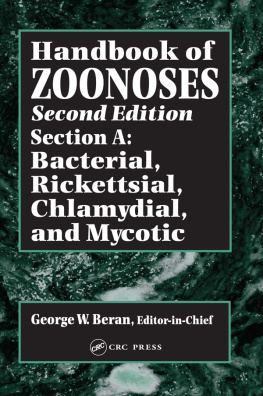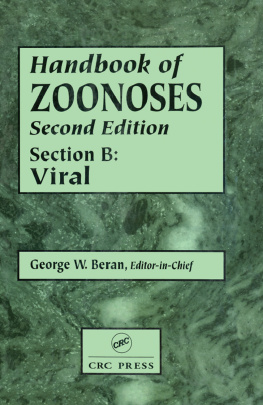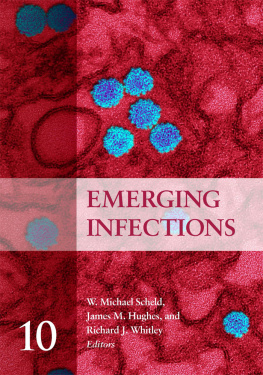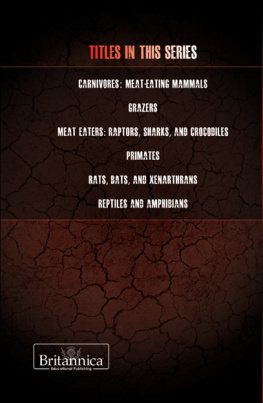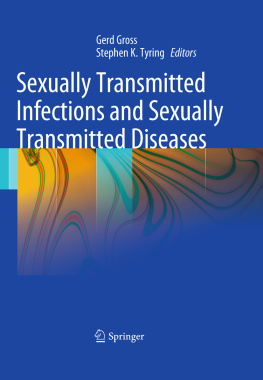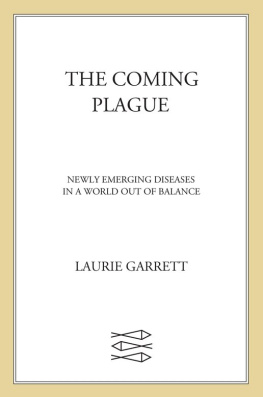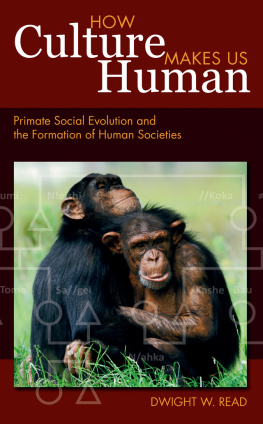The Primate Zoonoses
This book offers an accessible and up-to-date reference on primate zoo-noses. Recent years have witnessed a rise in human diseases zoonotically transferred from wild primates, with outbreaks such as Ebola and concerns regarding newly emerging infections. The authors go beyond simply providing an inventory of diseases, helping readers to understand how and why they are transmitted. Important consideration is given to the contemporary cultural and ecological factors involved.
Loretta A. Cormier is Associate Professor in the Department of Anthropology at the University of Alabama, USA.
Pauline E. Jolly is Professor in the Department of Epidemiology (School of Public Health) at the University of Alabama, USA.
First published 2018
by Routledge
2 Park Square, Milton Park, Abingdon, Oxon OX14 4RN
and by Routledge
711 Third Avenue, New York, NY 10017
Routledge is an imprint of the Taylor & Francis Group, an informa business
2018 Loretta A. Cormier and Pauline E. Jolly
The right of Loretta A. Cormier and Pauline E. Jolly to be identified as authors of this work has been asserted by them in accordance with sections 77 and 78 of the Copyright, Designs and Patents Act 1988.
All rights reserved. No part of this book may be reprinted or reproduced or utilised in any form or by any electronic, mechanical, or other means, now known or hereafter invented, including photocopying and recording, or in any information storage or retrieval system, without permission in writing from the publishers.
Trademark notice: Product or corporate names may be trademarks or registered trademarks, and are used only for identification and explanation without intent to infringe.
British Library Cataloguing-in-Publication Data
A catalogue record for this book is available from the British Library
Library of Congress Cataloging-in-Publication Data
A catalog record has been requested for this book
ISBN: 978-1-138-21950-2 (hbk)
ISBN: 978-1-315-41489-8 (ebk)
Typeset in Times New Roman
by Apex CoVantage, LLC
This Routledge Focus short form book addresses emerging primate zoo-noses in the context of culture change. Primate zoonoses are increasingly becoming a global concern. Many parasites of wild primates can be readily passed to humans due to our close biological relationship with nonhuman primates. A number of recent and emerging diseases have wrought this out including chikungunya, Zika, HIV/SIV, and Plasmodium knowlesi malaria. Wild primates are also implicated in the spread of the Ebola virus. Although the natural host is believed to be bats, humans have been infected after contact with African great apes, which presumably contracted it originally from bats or another host species.
An important aim of the book is to describe the cultural and ecological contexts in which the sharing of parasites occurs. For example, SIV is an ancient disease in several wild primate species, and the hunting of bushmeat has been implicated in its transmission to humans. However, the culture history of human ancestors using wild primates as food has been documented as early as Homo erectus in the archaeological record. It is important to understand the contemporary and ecological factors such as deforestation, development, and globalization that have created conditions that facilitated the AIDS pandemic. An additional concern is that when a parasite enters into a new population, the parasite may evolve and become more virulent. Both Zika and chikungunya are wild primate viruses that were first documented in humans in the mid-20th century, both with mild symptoms in humans. But as they have spread more widely in the human population, they have become more neurotoxic, as in the tragic cases of infants infected in utero being born with microcephaly and other neurological issues.
The main focus of the book is the spread of parasites from wild primates to humans. Nonhuman primates have long been used as experimental models in research, testing of vaccines and antibiotics for human diseases, because many are often susceptible. But here, the primary concern is with those parasites that have spread in natural contexts. Where applicable, mention is given to research centers or zoos where captive primates have unintentionally been infected with human parasites. For example, there are cases of African primates in U.S. zoos that have tested seropositive for the vector-borne American Trypanosoma , presumably due to being housed in outdoor environments. Attention is also given to the acquisition of human parasites by wild primates, which is becoming more common in nature preserves with ecotourism. Ironically, the preserves that were intended to protect wild primates can increase their potential for exposure to novel human parasites. Such anthroponoses in wild primates can have potentially devastating effects on endangered wild primate populations.
The first part of this book addresses the ecological context for wild primate zoonoses, including a discussion of emerging infectious disease, modes of transmission, and cross-infection. Also addressed are anthropogenic contexts that have altered host-parasite relationships and facilitated parasite sharing. The remainder of the book addresses four broad categories of parasites: viruses, protozoa, bacteria, and helminths. For each category, the parasites known to be shared by humans and wild primates are discussed.
1
The ecological context
Emerging infectious disease
Nonhuman primates contribute substantially to emerging infectious diseases in humans. Of the approximately 75% of emerging pathogens that are also zoonotic, nearly 25% are found in nonhuman primates (Cleave-land et al. 2007; Taylor et al. 2001). Both the major taxa of the organisms (viruses, bacteria, protozoa, and helminths) and their mode of transmission play important roles in the potential for a given parasite to become an emerging infection in humans. According to Taylor et al. (2001), although virtually all of the helminths (parasitic worms) can be considered potentially zoonotic, they are far less likely to be the source of an emerging infection than viruses or protozoa are. More narrowly, considering helminth cross-transmission among human and nonhuman primates, the literature review for this book identified numerous studies demonstrating broad susceptibility among species in the order Primates to each others helminths. However, they are rarely the source of emerging infections. Two notable exceptions are the lymphatic filariasis and the larvae (cercariae) of schistosomiasis, which are both vector-borne. All vector-borne parasites have a higher risk of becoming emerging infectious disease than parasites transmitted through other means have (Taylor et al. 2001). The ecological context is also of paramount importance in understanding under what conditions any given parasite may potentially be spread among species.
Zoonoses and anthroponoses
The World Health Organization (WHO) defines a zoonosis as any disease or infection that is naturally transmissible from vertebrate animals to humans (WHO 2016a). The phrase naturally transmitted excludes infections that are intentionally induced in laboratory settings. In the past, humans have also been the subject of experimental infection with animal pathogens. One example involves studies in the 1960s when over 200 prisoners were inoculated with various strains of wild primate malarias to determine if infections could be established in humans (Coatney 1968; Cormier 2011). Many species of wild primates have been used as models in the study of human diseases, particularly Rhesus macaques, chimpanzees, owl monkeys, and squirrel monkeys. However, acquisition under experimental conditions should not technically be considered cases of zoonotic or anthroponotic disease, although such studies can provide information about potential susceptibility.


